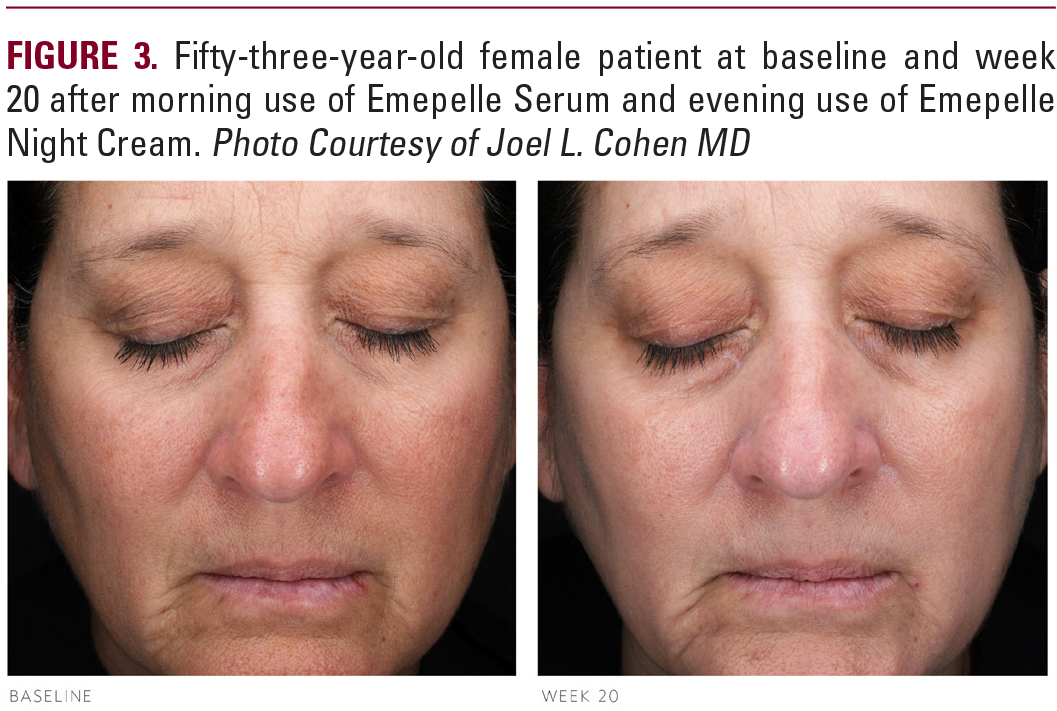

more estrogen receptors and turn the pathways back on. This suggests that the longer patients have been amenorrheic, the more of their estrogen receptors have been lost, or at least have FIGURE 5: Sixty-three-year-old female Patient at baseline and week 20 after morning use of Emepelle Serum and evening use of Emepelle Night Cream. Photo Courtesy of Joel L. Cohen MD become more dormant or down-regulated.
CONCLUSION
The significance of MEP technology is that it is a non-hormonal estrogen receptor activator that specifically addresses signs and symptoms of Estrogen Deficient Skin. Estrogen attenua- tion begins to take place in perimenopause and is accelerated in menopause. Again, it is important to indicate that MEP is a non-hormonal estrogen receptor activator that is specific to the skin. It is not a hormone, yet, has specific effects on specific skin.
receptors only. Restoration of estrogen-like skin effects might induce the production of collagen.5 The ability to stimulate col- lagen and improve symptoms including dryness, dullness, and fine lines is a benefit to patients with Estrogen Deficient Skin.
In this evaluation, the efficacy of a skin care regimen contain- ing Methyl Estradiolpropanoate for the treatment of facial aging was assessed over 20 weeks. Results showed the regimen im- proved wrinkles, texture, color, and hydration. Patients in the study indicated very high satisfaction with the formulations of Emepelle Serum and the Night Cream. Younger patients in the study spectrum seemed to show significant improvement by about 8 weeks. Older patients who have been in menopause longer showed notable improvement by 20 weeks.
Further study on the effects of MEP technology may lead to bet- ter treatments for premenopausal patients and pre-juvenation skin care regimens.
DISCLOSURE
REFERENCES
2. Hall G, Phillips TJ. Estrogen and skin: the effects of estrogen, menopause, and hormone replacement therapy on the skin. J Am Acad Dermatol. 2005;53:555-68.
3. Archer DF. Postmenopausal skin and estrogen. Gynecol Endocrinol. 2012;28(suppl 2):2-6.
4. Ashcroft GS, Dodsworth J, vanBoxtel E, Tarnuzzer RW, Horan MA, Schultz GS, et al. Estrogen accelerates cutaneous wound healing associated with an increase in TGF-beta1 levels. Nat Med. 1997; 3: 1209-1215
5. Draelos ZD. A double-blind randomized pilot study evaluating the safety and efficacy of topical MEP in the facial appearance improvement of estrogen deficient females. J Drugs Dermatol. 2018:17:1186-1190
6. Guven C, Dal F, Ahbab MA et al. Low dose monoethyl phthalate (MEP) ex- posure triggers proliferation by activating PDX-1 at 1.1B4 human pancreatic beta cells. Food and Chemical Toxicology. 2016. 93:41-50)
7. Katzenellenbogen BS. Estrogen receptors: bioactivities and interactions with cell signaling pathways. 1996. Biol Reprod. 54:287-293.
8. Bissett DL, Oblong JE, Berge CA. Niacinamide: A B vitamin that improves aging facial skin appearance. Dermatol Surg. 31:7:860-865.
9. Levin J, Momin SB. How much do we really know about our favorite cosme- ceutical ingredients? J Clin Aesthet Dermatol. 3(2); 2010. 22-41.
10. Traber MG, Stevens JF. Vitamins C and E: Beneficial effects from a mecha- nistic perspective. Free Radic Biol Med. 2011. 51(5). 1000-1013.
11. Addor FAS. Antioxidants in dermatology. An Bras Dematol. 2017. 92(3): 356-363.
12. Papakonstantinou E, Roth M, Karakiulakis G. Hyaluronic acid: A key molecule in skin aging. 2012. Dermatoendocrinol. 4:(3) 253-258.
13. Kang S, Fisher GJ, Vorhees JJ. Photoaging: pathogenesis, prevention, and treatment. Clin Geriatr Med. 2001. 17(4):643-659.
14. Fisher GJ, Quan T, Purohit T, Shao Y et al. Collagen fragmentation promotes oxidative stress and elevates matrix metalloproteinase-1 in fibroblasts in aged human skin. Am J Pathol. 2009 174:101-114.
15. Affinito (was 6) P, Palomba S, Sorrention C. Di Carlo C,Bifulco G, Arienzo MP, Nappi C. Effects of postmenopausal hypoestorgenism of skin collagen. Maturitas. 1999.15;33(3):239-47.
16. Rzepecki AK, Murase J, Juran R, Fabi S, McLellan B. Estrogen deficient skin: the role of topical therapy. Int J Womens Dermatol. 2019;5:85-90.






